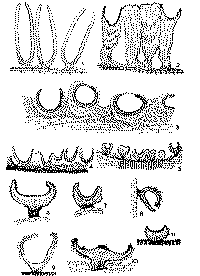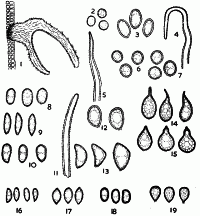|
 Lachnella turbinata Lachnella turbinata
SynonymsCyphella turbinata
BiostatusPresent in region - Indigenous. Endemic
Images (click to enlarge)
Caption: FIG. 11; Section through pileus of Cyphella turbinata. | 
Caption: FIG. 15: Spores of Cyphella turbinata. |
Article: Cooke, W.B. (1961). The cyphellaceous fungi. A study in the Porotheleaceae. Beihefte zur Sydowia 4: 144 p.
Description: Receptacles scattered, membranous, waxy, fragile, 0,1-0,5 mm. in diameter, attached by a
brief stem-like base, at first subglobose becoming urecolate or discoid; exterior dingy white,
covered with a scanty tomentum, hairs 4-6 µ in diameter, wall 0,5 µ thick, hyaline, finely
crystal coated; margin inturned, fimbriate; hymenial surface slightly concave, white or cream;
context white, to 80 µ thick, to 250 µ at the base, of radiately arranged mainly parallel
hyphae; generative hyphae 5-6 µ in diameter, wall 0,25 µ thick, branched, septate, hyaline;
hymenial layer to 80 µ deep, paraphyses filiform, somewhat scanty, apices acuminate; basidia
clavate, some almost capitate, 60-80 x 16-20 µ 4-spored; spores turbinate, 14-16 x 10-12 µ,
smooth, hyaline.
Habitat: Habitat: On Olearia paniculata.
Notes: The above description was taken from Cunningham (1953). The writer found abundant
surface hairs 200-250 µ long, 7,2-9,0 µ in diameter, covered with fine crystalline material;
the basidia in the portion of the type kindly loaned by Dr. Cunningham measured 50-55 x
7,2-9,0 µ. The spores measured 18 x 12,5 µ and the basidia have clamps at the base. The
paraphyses-like bodies were 5-6 µ in diameter. In this and in L. pyriforma these bodies are
either young basidia or cystidioles.
Article: Cunningham, G.H. (1948). New Zealand Polyporaceae. 3. The genus Polyporus. New Zealand Department of Scientific and Industrial Research, Plant Diseases Division, Bulletin 74: 39 p.
Description: Pilei annual, scattered, membranous, waxy, fragile, 0.1-0.5 mm. diameter, attached by a brief
stem-like base, at first subglobose becoming urceolate or discoid; exterior dingy white,
covered with a scanty tomentum, hairs 4-6 µ diameter, wall 0-5 µ thick, hyaline, finely crystal
coated; margin inturned, fimbriate; hymenial surface slightly concave, white or cream.
Context white, to 80 µ thick, to 250 µ at the base, of radiately arranged mainly parallel
hyphae; generative hyphae 5-6 µ diameter, wall 0.25 µ thick, branched, septate, hyaline.
Hymenial layer to 80 µ deep, paraphyses filiform, somewhat scanty, apices acuminate.
Basidia clavate, some almost capitate, 60-80 x 16-20 µ, 4-spored. Spores turbinate, 14-16 x
10-12 µ, smooth, hyaline.
Habitat: HABITAT. Scattered on bark of dead twigs.
Distribution: DISTRIBUTION. New Zealand.
Notes: Separated from C. villosa by the small size of the pilei, rather scanty tomentum, large. almost
capitate basidia and turbinate spores. The latter show a general resemblance to those of C.
pyriforma, differing in shape and smaller size.
|